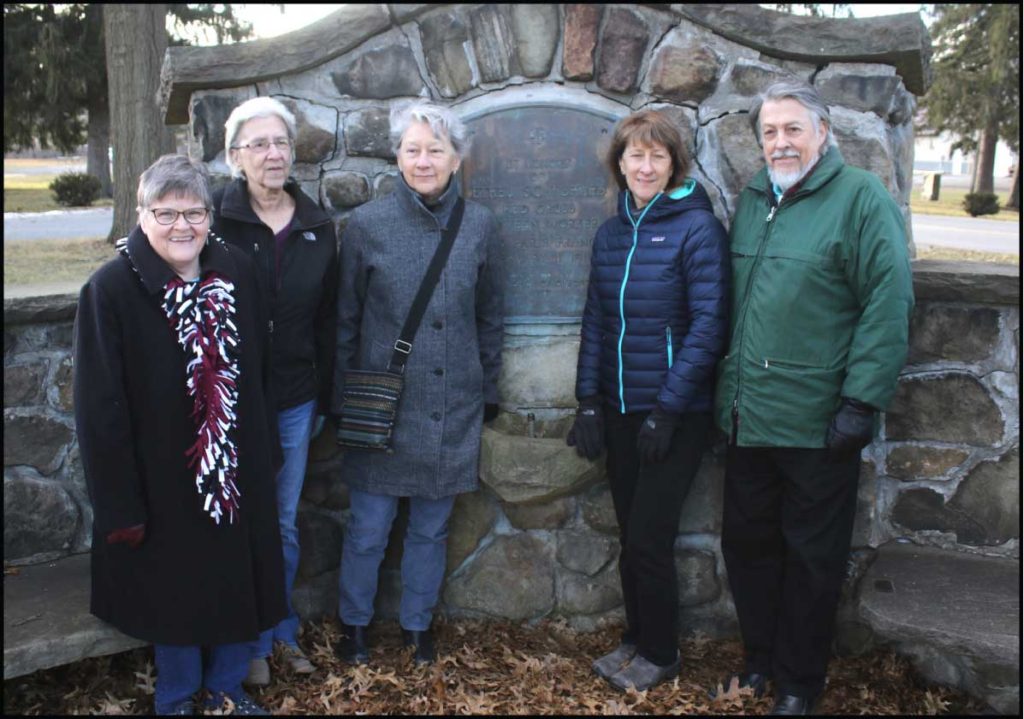REPAIR IT, ARDENT FAN SAYS
100 Years Later,
Monument To Dedicated
Lady Declines

By LIBBY CUDMORE
ONEONTA – On Memorial Day 1922, Mayor C.C. Miller accepted the memorial to Ethel Scatchard, calling upon “all citizens to revere the name of Miss Scatchard and to take a lesson from her spirit of usefulness and service.”
Now 100 years after her death in Paris, historian Robert Calendresa wants the city to honor that promise.
“The monument, frankly, is deteriorating,” he said during his presentation on her life Saturday, Feb. 9, at the Oneonta History Center. “While the city endlessly debates wine bars, beverage centers and food courts, poor Ethel’s monument remains neglected.”
Calendresa, who has researched Scatchard’s life for more than a decade, made the plea in honor of the 100th anniversary of death from pneumonia Feb. 11, 1919, in the French capital, where she had been working at a Red Cross canteen following the Armistice that ended World War I.
“I would always go walking in the park and see the plaque,” he said. “There were so many more questions than there were answers.”
Scatchard, the daughter of Elmer and Fannie Scatchard, worked as a director, and later supervisor, at the Waterbury (Conn.) Institute of Craft & Industry. When the war broke out, she returned to Oneonta to work as a secretary at the local Red Cross chapter, as well as teaching courses in surgical dressing.
One year before her death, the Otsego County Farm Bureau News reported that she had given a talk on meat substitutes to the Women’s Club.
“But that wasn’t enough,” said Calendresa. “She wanted to be of service, and get directly involved, so she signed up for overseas service.”
She left to set sail for France Nov 20, 1918, just nine days after the end of WWI, and worked at the canteen in Gare du Nord, the famous railroad station, for just under two months before her death at age 32.
Though a civilian, she was buried with full military honors in Suresnes American Cemetery. Though the government sent three letters to her mother offering to bring her remains home, the letters, Calendresa said, went unanswered.
The funds for her memorial were raised in a campaign spearheaded by her friend Florence Hemstreet, president of the Women’s Club, of which Ethel had been a member. “She went to art school in Boston, so her area of study went to good use designing the monument we see today,” said Calendresa.
Her love of nature was reflected in the monument’s design, with the drinking fountain draining into a birdbath, which then drains into a stone-enclosed pool where dogs and other animals drink.
However, Calendresa noted, the drinking fountain has not worked for as long as he can remember.
The monument cost $1,200 and was made possible by donations from over 4,000 women, including girls from the local Girl Scout troops.
Scatchard’s great nieces, Joann Launt, Karen Bruning, Pat Wheeler and Nancy O’Hera, were at Calendresa’s talk, and also support fixing the monument.
Wheeler’s daughter Megan Beauchamp, along with her husband Tom and two daughters, Grace and Paige, visited Scatchard’s grave this past July.


I am always amazed at these women who served our military during and after WW I. They were true patriots without a doubt and all deserved a military honors funeral. What they went through just to get to Europe. Hoping Miss Scatchard’s memorial is by now fixed and operating.